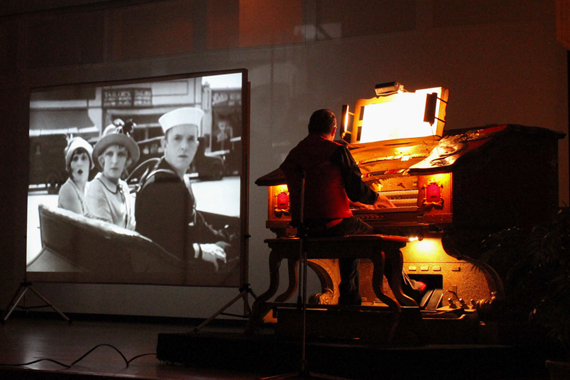
Ever heard of Lady Barton? She’s a Flint native, born in 1927 and still performing her heart out for crowds of fans to this day.
The Lady Barton Theatre Organ was the showcase of Pipe-a-Palooza II, the Flint Theatre Organ Club’s most popular presentation of their treasured lady, on the evenings of July 19 and 20 at MacArthur Recital Hall. The organ was built in 1927 and installed in the Capitol Theatre for its 1928 grand opening. Silent films were shown there each night with an accompanying organ performance. Historically, a banquet preceded the Saturday evening film presentations.
Now residing at the Recital Hall, the organ is entertaining a new generation of Flint residents with classic performances through its unique installation. The controls of the organ—the keys, pedals, knobs, and switches—are centrally located on what is known as the console of the organ, and the console is seated on stage; yet, the organ itself is embedded in the very walls of the FIM. The sound of the organ emits from large rectangular-shaped openings on each side of the stage, and is increased or muted by shades, not unlike those of a patio door, which rotate by the operator’s will.
Dave Moreno served as Pipe-a-Palooza’s guest organist. The Californian began playing the instrument as a child, and has spent over 30 years playing in vintage organ theatres across the nation. He has over 200 silent films in his personal collection, and he prefers to call the theatre organ by its original name, the unit orchestra, as christened by one Robert Hope-Jones, the 19th-century inventor recognized as the father of the theatre organ. In speaking on the effect that the organ has on a silent film, Moreno said, “We try to give a movie as much sound as we can. People have left performances thinking that they heard dialogue in the silent film.”
The Friday night performance included Laurel and Hardy silent works, as well as contemporary songs and the comedy styling of Moreno between the films. Chuck and Wendy Mueller of Mueller’s Orchard in Linden came out for the Friday night show. “We just like organ music,” the couple said, and Wendy went on to say that she appreciated that the period of the silent films matched the time period of the organ, that being the late 1920s. Chuck stated that he’d like to join the organ club just to “work on the organ.”
The Flint Theatre Organ Club has been organized since 1967. They have long cared for the Lady Barton, volunteering their time to ensure her sustainability, originally at the Capitol Theatre and now as part of the FIM. They had been accustomed to putting on no more than a couple of events a year, but due to a growing public interest in the Lady Barton and silent films, they are now managing up to seven events annually, including one called All Things Irish at FIM for St. Patrick’s Day. Gregory Shells is a spokesman for the club. He said that the club is thankful for the help of FIM in preserving the legacy of Lady Barton. “We have a lot of support from Paul Torre and FIM. They are the ones who make this thing possible.”
With a permanent venue at FIM and a growing crowd of fans, the Flint Theatre Organ Club will continue to add more shows to their calendar year. It makes for an eventful time for everyone – from those who merely suffer from intermittent fits of nostalgia, all the way to those who suffer from a serious case of golden-age thinking—a condition this writer will readily admit to having. But no matter the man’s state, the chance to hear the sounds of the Lady Barton is a wondrous experience for all.
PHOTOS BY NAARAH MYERS
Are you interested in purchasing photos from this story? Go HERE and select the “Pipe-a-Palooza” category.













